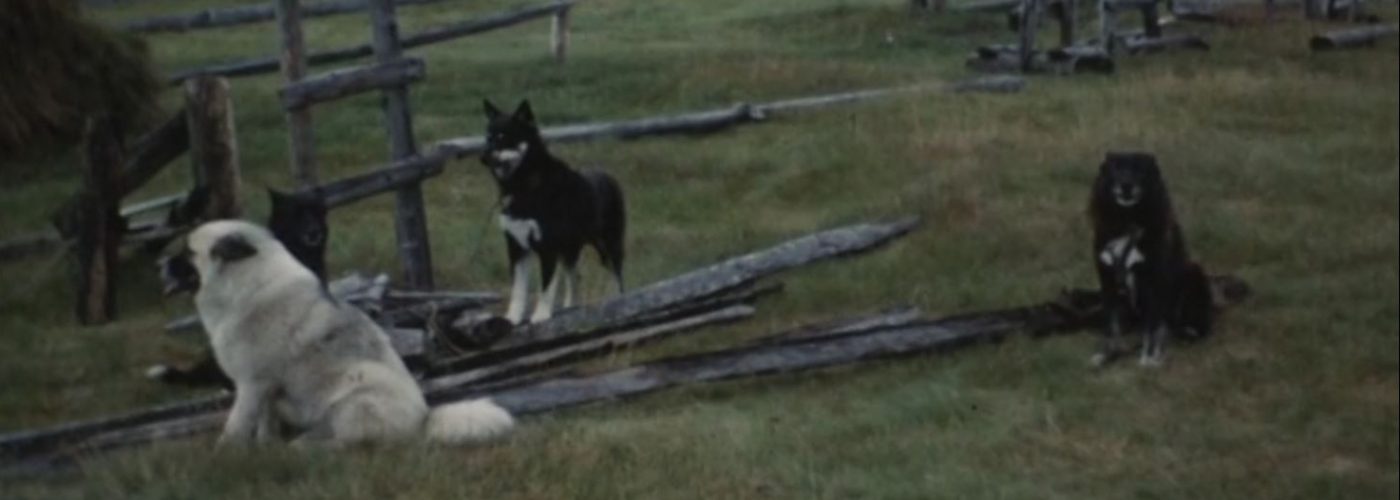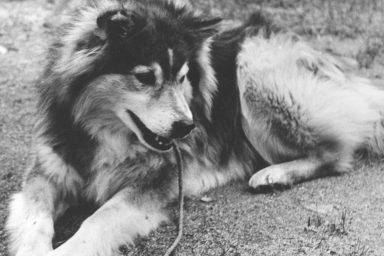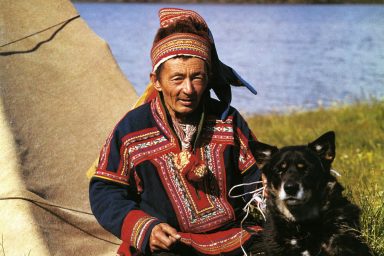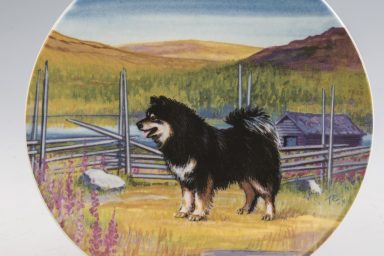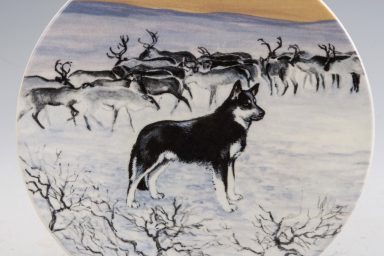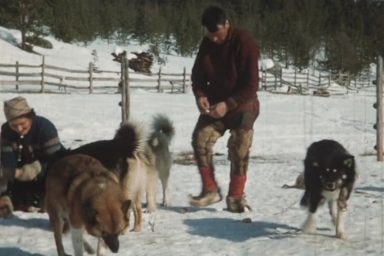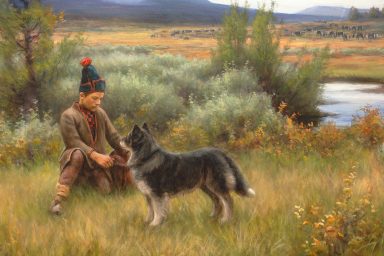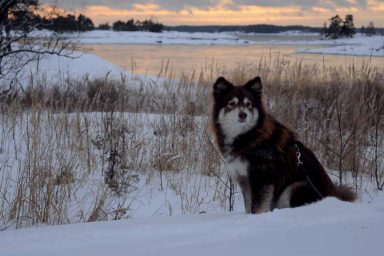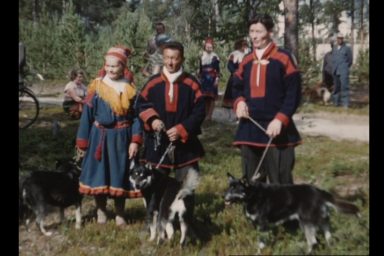Despite the horrors of the Lapland War (1944–1945), Lappish dogs weren’t completely destroyed. Immediately after the war, the Kennel Federation and Kennel Club of the time (before they merged to form the Finnish Kennel Club) began to chart the dogs of Finland, and people started recreating the Lappish breeds. The Kennel Club was originally Swedish-speaking, and it followed Sweden’s model as it gathered information about Lappish dogs. At that time, the objective was to create a uniform Lappish breed.
In Finland, the Lappish Herder received its breed standard in 1945, and it was recognized by the Fédération Cynologique Internationale (FCI, World Canine Organisation) the following year. These types of dogs are also known as Kukonharju Dogs. The reindeer dogs of the fell region were the ideal in breeding, but the original foundation stock were not Lappish working dogs. They were from Pello and the Savukoski area, not the fell region. Samoyed dogs and Karelian Bear Dogs, among others, are mentioned as ancestors of the breed. The breed standard was quite extensive, and it did not differentiate between long- or short-haired dogs. Kukonharju dogs are no longer in the ancestry of modern Finnish Lapphunds.
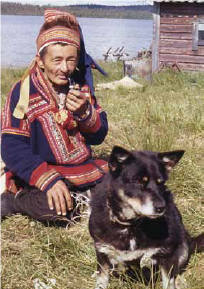
While the Kennel Club achieved the milestone of registering the Lappish Herder, the Kennel Federation continued developing a Finnish dog breed that was equipped to herd reindeer in Lapland. The Swedish Lapphund wasn’t suitable for working in the north because of its coat, and the Lappish Herder was also developing into something unlike the original Lappish herding dogs.
The preliminary development of the Lapponian Herder began in the 1950s, when dogs were charted and counted in Lapland. Chairman of the Kennel Federation at the time, Lieutenant General Olli Korhonen, was indispensable as he, for example, travelled through Lapland interviewing reindeer herdsmen. He found out that the herding dogs still in use were long-tailed and short-haired spitz of the Menesjärvi type.
In practice, there was only one registered breed of Lappish dogs in the 1950s, that constituted a very multiform native breed. These dogs were extremely varying in their colour, structure, and coat.
Much work was done in the 1960s to register and establish two different types of Lappish dog breeds. But a major setback struck in 1962, when the above-mentioned two significant kennel associations merged, and two different types of Lappish dogs were placed in the same register. The long-haired Kukonharju dogs from Southern Finland and the short-haired herding dogs found in Lapland during the charting endeavour in 1959–61, or the Menesjärvi dogs, could now officially breed together.
The Lapponian Herder receives its own breed standard in the 1960s
The problems were however noted quickly, and the registers were once again separated in 1966. The Menesjärvi dogs got their first breed standard in 1967 and were named Lapponian Herders. At the same time, the Lappish Herder’s name became the Lapphund. The Lapphund was a fairly square-proportioned dog type with a handsome, thick coat and a sociable, calm character. Because of its long coat, it wasn’t as good in snow as the Lapponian Herder, but as a companion and sports dog it was very popular right from the start.
The original breed standard was revised in the 1970s. In one decade, the Menesjärvi type (see info box) of the first breed standard had spread from Inari to Western Lapland. At the same time, focusing on appearance at the expense of working characteristics had become a problem. Many excellent reindeer dogs were left outside the official breed standard because of colour or conformation criteria.
The Lapponian Herder’s thick and wiry double coat protects it effectively from the cold and moisture. It can manage well even in deep snow. In Lapland, their coat is called ‘närpiäkarvainen’, which means somewhat short, bristly, yet glossy and water-proof, to differ from Lapphunds ‘rössökarvainen’, shaggy-haired coat.
A research project was undertaken in 1974 to try to get the breeding of the Lapponian Herder back on the right track. The study revealed that the young generation included alarmingly few genuine herding dogs, and the number of cross-breeds was rising. Good females were the hardest to find. To solve the problem, kennels were established where both sexes would be bred equally. Private families also took on the responsibility of raising females. They could easily be raised even outside the reindeer herding area.
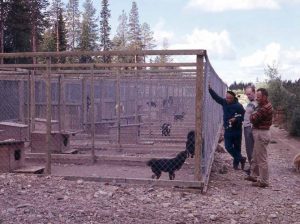
Still in the 1970s, several different types of reindeer dogs that were valued by old-school reindeer herdsmen could be found in Lapland. The Menesjärvi type was only one of many. The situation was particularly good in North-Western Lapland, where the herding culture had prevailed, even over the snowmobile. The reason was that dogs were better at keeping reindeer on the right side of the border.
Even though the breeds had been separated, distinct differences weren’t always seen in their appearance, even in the 1970s. Coat length was a difficult characteristic because both long and short-haired dogs were born to both breeds, even within the same litter. That is why people started focusing more and more on the dogs’ proportions, limb structure (hock angle), and tail carriage in the 1980s.
A register is established for the long-haired Lappish dog in the 1970s
The 1970s were a significant decade for the development of the present-day Lapphund. In 1971, a register was established for the long-haired Lappish dog, the modern Finnish Lapphund. Modern dogs are descended from the Lappish dogs of this era. Breeding consulting for Lapphunds was begun in 1973, and in 1975 the Lapphund received a new breed standard.
An important point in the new standard was an arctic conformation. The standard size was now smaller than in the Kukonharju type, and the tail had to bend up onto the back when in motion. The Lapphund’s body was defined as slightly longer than its height, which gave them a strong general conformation. The head needed to have strong features and a short muzzle. Two of the first significant males of the new type were Kalikkakaula (‘Stick Neck’) and Lecibsin Torsti.
The coat of the Finnish Lapphund is thick and coarse, and enthusiasts like to call them ‘rössökarvainen’, or shaggy-haired (as near a translation as can be made of the colloquial word!)
The new standard demanded coat uniformity, although all colours were still permissible. The coat had to be thick and coarse to differentiate it from the shorter coat of the Lapponian Herder. The outer coat had to be long, coarse, and weather-proof. In addition, the Lappish dogs had different types of gaits.
The definition of the breed’s conformation has been established over the last 30 years, and breeding data has been gathered since the early 1980s. The Lapphund’s name became the Finnish Lapphund in 1993, and the present breed standard dates from 1996. It defines the Finnish Lapphund’s size as slightly smaller than the standard of 1975. In 1996, the Finnish Lapphund joined the PEVISA Program, which works to prevent hereditary defects and diseases, and nowadays, it is quite a healthy breed.
MENESJÄRVI REINDEER DOGS
Elli and Matti Jomppanen lived in Menesjärvi of Inari in the 1960s, and the first breed standard of the Lapponian Herder in 1966 was based on their dogs. The family had a long history of breeding, and thanks to their quick and far-sighted action, the Lapponian Herder survived the Lapland War. Matti Jomppanen urged a group of reindeer keepers to stay on a remote fell with their dogs and reindeer while everyone else was evacuated. In this way, they saved the lives of some dogs. The Lapponian Herder’s first breed standard and its Menesjärvi tradition gave strict criteria for the dog’s appearance. It had to have a short, black coat with tan markings. This so-called four-eyed colouring meant that the dog had light-coloured spots above its eyes. One of the most significant Menesjärvi foundation males was Menes-Lappi. Many of the Menesjärvi characteristics are still clearly visible in today’s Lapponian Herders. For example, they are dark-coloured and fairly short-coated, and they have a narrow head and straight tail, and most often pricked ears.
Source: Dogs of Lapland – Cheerfully present (2012). Sanna Karppinen. Lappalaiskoirat ry, Kirjakaari, Jyväskylä.
